Sunday, November 08, 2009
You can lead a horse to water...
He lit it as soon as he got into his car.
And we didn't have our camera.
Wednesday, October 07, 2009
Messing Up At Work
I am so glad that when I make a mistake at work it does not make the news. Here in Buffalo we’ve had 2 recent, very prominent work mistakes.
The first mistake was in one of the first Buffalo Bills football games of the season. I won’t even try to explain in detail, as my attempt to describe football plays is equivalent to the folks who see me spinning on my wheel at events and say to their children, “Look what she’s weaving,” or the people who explain the Devil’s Hole with, “gravity sticks you to the wall.” Instead, I will just say that it was the end of the game, the Bills were in the lead, and this player made a choice that allowed the opposing team to win. Most of the people I’ve heard talking about it believe that the choice he made was not what he was coached to do. Two local teenagers decided to express their dissatisfaction with his final play by vandalizing his lawn with a word that cannot be said on the radio.
This week, a prisoner briefly escaped from the holding center. Apparently he got out through a roof access hatch that was supposed to be locked. The guard who was responsible for locking it and checking it has been suspended.
Both incidents made the news for multiple days.
It seems to me that the football screw up was pretty minor—an error in judgement at the worst possible point in the game. No one was hurt, and he has been kind enough not to press charges against the lawn vandals. The jail screw up had huge repercussions, including a (thankfully) successful manhunt for an escaped prisoner who was deemed dangerous. Of course this one was a serious mistake, but honestly, I can’t count how many times I’ve left the iron on when leaving a costume shop at night, and I know I forgot to lock the door at least once. I wouldn’t even think of those things when trying to list ways that I’ve screwed up at my job. Thank goodness I’m not a prison guard.
My biggest mistakes in my job, as far as I can remember:
1. I accidentally shattered all the buttons down the front of a jacket with a hammer. Really, this was an accident, I was using a hammer and die on another kind of closure behind the buttons and didn’t notice until each and every one was in pieces.
2. I scraped an opera singer’s leg with a safety pin, drawing some blood. She was really gracious about it.
3. I cut the short wide man’s vest out of the fabric meant for the tall thin man’s vest. This one really sucked, because they were both intricately patterned fabrics, and not only had I taken the time to match the center fronts, facings, and pocket flaps when I cut the wrong one, but I had to figure out how to do it again with the scraps to cut the correct vest. I managed to fix it without having to declare what I had done wrong, or ask for more of the expensive fabric, but when I admitted to this months later, my co-workers told me that I had acted really squirrelly that day but they couldn’t figure out why.
4. I made my stitcher Larisa spend a full day beautifully pin-tucking the yoke of a Victorian nightgown, only to be reminded in the fitting by the designer that it was supposed to be made out of a piece of ready made lace fabric, no pin-tucking required.
5. In my very first costume shop internship, after declaring my great math skills, I miscalculated the length of fabric I needed to pleat and had to go back to the first hand and tell her it was too short. I thought it was the end of the world; she told me to figure out how much more was needed and make sure the seam was hidden behind a pleat.
6. I can’t even count how many times I have accidentally snipped a hole in a garment or myself.
7. My hands are covered in tiny scares, either from the aforementioned snips or from iron burns.
8. Neither can I count how many times I have bled on a costume.
9. In my first job, as a wardrobe mistress, I almost never got all the girls completely closed into their dresses during their quick change. In my defense, I was 17 and completely untrained. However, I am still complete crap at wardrobe.
10. Also in that first job, I put a rosary through the wash. If I was Catholic this would be a much bigger worry for me.
11. I flooded my shop and the downstairs hallway of the building it is in 3 times, thanks to a faulty washing machine. The first time was after 7pm on a Friday, and I had to call the after hours maintenance guys to come clean up after my mistake. It’s super embarrassing for your students to see you shop-vac-ing up a giant puddle you created. It’s also a lot harder to remain scary and intimidating to them after that.
12. I altered a suit coat in a crappy manner, and made it too tight.
13. I distracted and interrupted Wendy Wasserstein during the dress rehearsal of the first and only opera for which she wrote the libretto. When she turned towards me, and I realized my mistake, I blurted out "I'm sorry, I thought you were someone else," and scampered off into the dark again.
None of these made the news. None of them caused a death or an emergency, and only one resulted in injury. Many of them have led to really great learning experiences. I don’t think anyone I’ve worked with would disagree that I’m really good at reweaving holes in fabric. Most were made by moths or cigarettes, but a few were made by me.
I’m thankful every day that my mistakes at work are private, and most can be fixed with a seam ripper, new buttons, or a needle and thread. I can’t imagine what it’s like for surgeons, whose mistakes could end in a loss of life.
I’m also glad that my work mistakes aren’t open to the criticism of every arm chair quarterback in Buffalo. The last thing I need is a bunch of guys who can’t thread a needle discussion at length how I should have chosen a double dart instead of a single, or how the sleeve isn’t hung quite right.
Monday, September 21, 2009
Update
Here are a few pictures taken when we first moved in back in the spring:
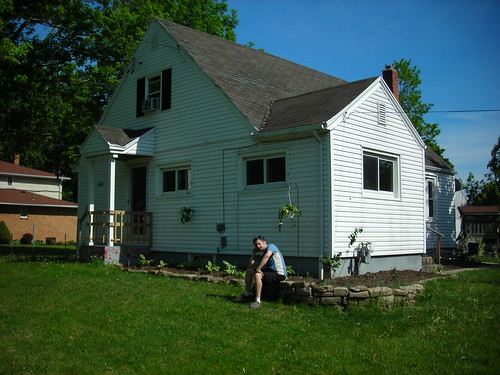

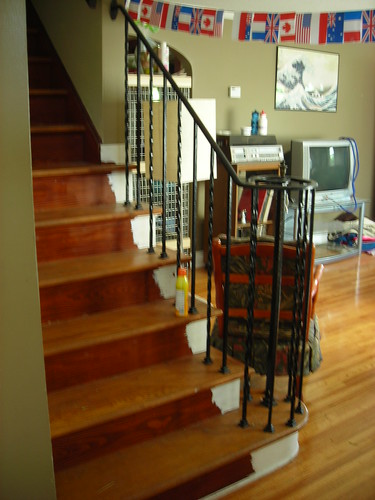

We expect to close in mid-October, so I finally feel safe posting pictures and saying that, "Oh yes, it will be ours."
Since the photos were taken, we've completely removed the chain link fence closing in the side yard, painted the garage, patched the roof, and done various inside repairs. We're beginning to create the Japanese inspired backyard Chris has envisioned and we've done a lot more planting, including some glorious sunflowers Chris has planted throughout the property.
I will try to scan some knitting to share soon.
Wednesday, September 16, 2009
About Grandpa
Recently my grandfather died. He succumbed to Alzheimer’s disease. I don’t usually use this blog for highly personal writing but there are some memories of my grandfather that I would like to share in a more public way.
Grandpa was 92 years old when he died. He grew up in the small town of Seymour Indiana, a town with a full page of Stuckwisches in their phone book. His family, like my other 3 grandparents’ families, were farmers. At that time, farm kids only went to school through the 8th grade, after that they were needed on the farm. My grandfather became the first person in his family to go to high school. Not only did he earn the first high school diploma in his family, he also went on to college, graduate school, and a PhD in chemistry. Grandpa began the family tradition of paying for his children’s bachelor’s degrees completely, with the understanding that the kids would take over the cost of their education beyond their bachelor’s. My father always referred to this as “the only trickledown theory that works.” Two of grandpa’s children have also earned doctorates, and I am one of the few members of our family with only a bachelor’s degree.
Grandpa used to joke that he had to go away to college in order to meet a woman he wasn’t related to. My grandmother grew up in Blairstown Iowa. She wanted to go to college, but her father believed that there were only 3 reasons to go to college: to become a minister, to become a doctor, or to become a teacher. At that time the Lutheran church did not ordain women, and my great grandfather apparently didn’t believe women could/should become doctors, so grandma became a teacher. If you google our last name, you will find many teachers. Many Stuckwisches are listed on elementary school, high school and university websites as teachers and staff.
Our first relative in this country in the Stuckwisch line came to escape German conscription. The story that has been passed down to me is that he knew someone who worked on the boat coming here, and that person helped him to hide in a pickle barrel, at least until the ship was beyond turning back. What no one in the family can tell me is whether or not there were still pickles in the barrel. No one else thought this an important enough part of the story to pass down. My father and both of his brothers were able to avoid Vietnam: my dad by becoming a teacher (an exempt profession), my uncle Steve due to a minor medical exemption, and according to the other two, David got out because he was lucky. His birthday was one of the last in the lottery. Also according to Dad and Steve, David was always Grandma’s favorite. As you can see, for the most part I come from a long line of draft dodgers. Even so, Grandpa tried to enlist in the air force during WWII. When they found out that he had a chemistry degree, they told him they didn’t want him, that he would do the war effort more good by finishing his doctorate in Chemistry and working here. He did work for Kodak during the war which he was not allowed to discuss at the time. We found out later that he worked on aerial color photography for Allied planes.
From Kodak my grandfather moved on to the academic world. As a chemistry professor, he worked at several universities and moved the family around the country a few times, which is probably part of why my aunts and uncles are scattered all over the US. He finally retired from a position as provost and executive vice president of the University of Miami in Florida. After retirement, he still preferred to live in university towns and hang around the universities there as much as they would let him.
About 10 years ago Grandpa moved back to the town of his birth and renewed an old friendship with a woman named Elsie. They had grown up together, and at one time Elsie and her late husband had double dated with Grandpa and Grandma. When we visited, Elsie would come with us to get Chinese food, which she loved but her own family didn’t much care for. At some point folks around town began to talk, possibly because there were other widows who “had their caps set” for Grandpa. I remember Grandpa’s frustration when he declared “We’re not fornicating, so it’s none of their business!” I privately thought that it still wouldn’t be their business even if fornication were involved.
By contrast, my maternal grandmother, who had a very similar upbringing, stayed in the house she moved into when she married my grandfather, in a small town here in western New York. Grandma DeVantier had been willing to buck social norms when she was young and newly married. In her small German Lutheran town families sat together in church on Sundays. When she moved with her husband to his neighboring small German Lutheran town, she discovered that they still sat with all the men on one side of the church, and all the women on the other. Apparently she integrated the church by sitting with her husband. I was so proud when I first heard that story. By the time that I knew her, Grandma DeVantier had become much more concerned about what the neighbors would think, and whether the other teenage girls were wearing clothing just as weird and outrageous as I was. Apparently if I was at least one of a crowd wearing a fashion she found ridiculous, it wouldn’t be so bad.
In February of ’08 Studio Arena Theater closed its doors and I lost my job. I went to Washington DC for 10 weeks of work and then to my recurring job at the Glimmerglass Opera. Those jobs held off unemployment for 5 months, and thank God I happened to be married to a guy with health insurance, but after Glimmerglass, in the fall of ’08 I had nothing lined up. A friend told me that a suitable position would be opening up at Buffalo State College, and I began to contemplate a major life change: I could continue freelancing around the country in professional theatre, affording me little time with my husband to whom I had been married for less than a year, or I could make a switch from professional theatre to academic theater. This would be a big change, and there were lots of things to take into consideration, but I couldn’t help but think about the contrast between the 2 grandparents I knew the best, Grandma DeVantier and Grandpa Stuckwisch. Grandma had stayed in a small community. The young people she knew were family members, and as she grew older she was not challenged to go beyond her comfort zone or continue to interact with young adults. Grandpa had lived the life of a college professor, actively pursuing new knowledge and new research and interacting with many, many young adults over the years. I see in myself the tendency to become set in my ways, and finally a bit afraid of change or new ideas, and I didn’t want that. Grandma DeVantier, whom I loved dearly, was clearly concerned the first time she saw the Simpsons, a show the rest of the family loved, including our family members who had also stayed in their small German Lutheran town. I remember around the same time watching a Monty Python marathon on TV with my brother Wade. Grandpa was visiting us and came into the room to see something that I’m sure would have scandalized Grandma DeVantier. Grandpa just commented, “Those guys are wacky, aren’t they?” and moved on.
As I contemplated embarking on a new life in a college community, I knew I wanted to hang on to that mental flexibility that I saw in Grandpa. I wanted to continue to pursue new knowledge and understanding, to appreciate new ideas, new comedy, and things that were intended to be shocking, without pulling back into myself, resisting, and withdrawing into a long established comfort zone. Grandpa was one part of why I made the choice to move into academic theater, which puts me very far outside my comfort zone, at least to begin with. I want to benefit in the same ways that he did, and retain the same mental youth and flexibility that I think he could at least partially attribute to life in a college community.
Thursday, July 16, 2009
Sew A Mile In Our Shoes
The disadvantage to this schedule for us in the shop is that we have about half the "standard" amount of time from the point at which we do a first mock-up fitting to the point when we need to put a wearable costume on stage. This year we did that in about a week and a half instead of the customary four weeks. So we find ourselves needing to make design and fit changes to garments we're still scrambling to finish. The challenge is to continue to work to Glimmerglass's high standards while making these deadlines.
One of the most time consuming costume details my team has created this summer is a skirt made of layers and layers of tulle, covered in tiers of tulle ruffles. (If you've forgotten, tulle is a soft net, most available in nylon.)
The numbers involved in this project (and remember they all translate to many hours of labor) are truly impressive. The inner layers which support the skirt include 8 layers of tulle, each of them 10 yards (30 feet) around. That took most of a 50 yard bolt of tulle. The ruffles are gathered onto a tulle base. In most fabrics a ruffle twice as long as the base to which it's sewn would look plenty full. Tulle has an amazing ability to gather, so a traditional 2:1 fullness looks less than skimpy. We ended up using a double layer of tulle for the ruffle, and gathering it 8:1 at the bottom, slightly less as the layers move up the skirt.

I cut the tiers by neatly wrapping the full yardage around a long cardboard card. Then I cut the correct tier depths through all the thicknesses with a rotary cutter. This probably saved hours of time over marking and cutting 13" from the bottom edge of 40 yards of net, then going back and doing it again for each of the rest of the 5 tiers.

The cardboard in the middle definitely made this process easier.
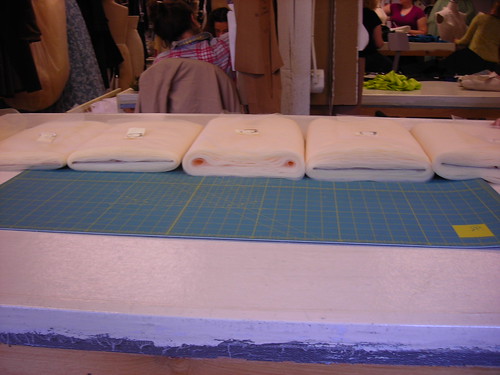
As mentioned, the tiers get fuller as they go down the skirt, which you can see by the varying thicknesses of the wound and cut net. The topmost ruffle is on the left, the bottom on the right.
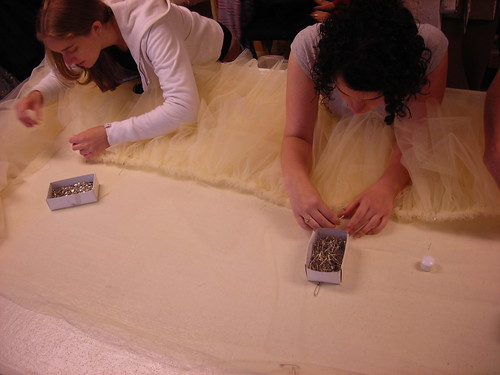
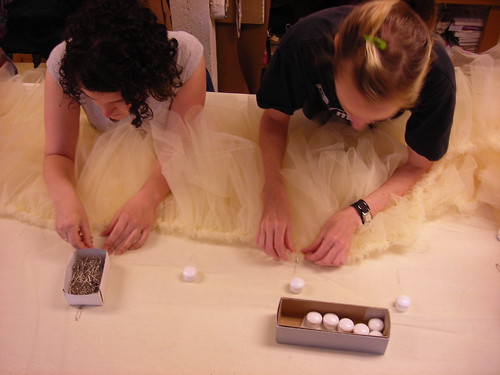
At least a half dozen costume technicians worked to gather, pin, and sew the tiers down to their base.

The finished skirt includes 220 yards of ruffle, all cut, gathered, and assembled in just a few days. That's on top of the 80 yards of tulle that hold the skirt out in its full shape. The hem underneath the bottom ruffle is held out to a circumference of over 3 yards by all of that tulle. I'm quite pleased with the final results, and my fantastic team!
3 Steps Forward, 2 Steps Back
This is how far I got under that plan:
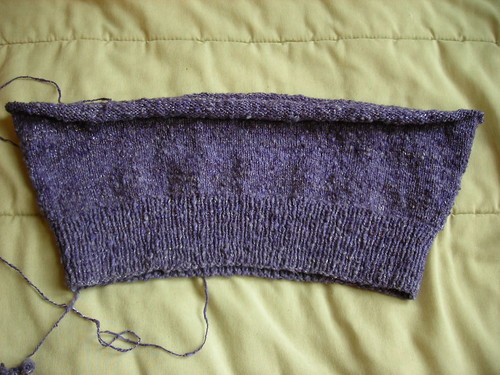 Knitting in the round affords lots of chances to try on a garment as it's being constructed, and correct errors well before the end. This was my try-0n point, the point at which I instantly regretted second guessing my original instinct to knit 5" of ribbing. The pattern (authentic 1950 you recall) only called for 3" of ribbing, and although I knew better, I deferred to the pattern at 3" because I was sick of knitting 1x1 rib. Also, the body increases were too close together and the body itself a bit looser than I had hoped for (or indeed than they appeared on the model).
Knitting in the round affords lots of chances to try on a garment as it's being constructed, and correct errors well before the end. This was my try-0n point, the point at which I instantly regretted second guessing my original instinct to knit 5" of ribbing. The pattern (authentic 1950 you recall) only called for 3" of ribbing, and although I knew better, I deferred to the pattern at 3" because I was sick of knitting 1x1 rib. Also, the body increases were too close together and the body itself a bit looser than I had hoped for (or indeed than they appeared on the model).
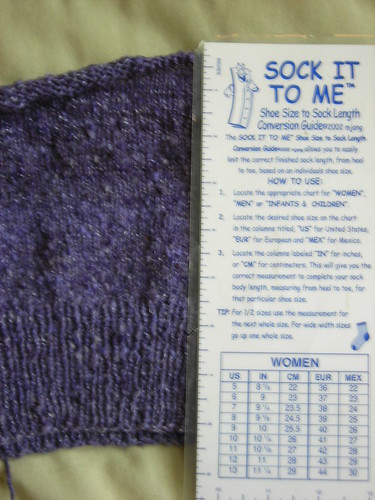
So instead of keeping 8" of the wrong thing, finishing it and hating it forever, I ripped out 5" of body back to the original 3" of ribbing.
 Discouraging to do, but from this point I knit the additional 2" of ribbing I should have started with, and reworked the body shape and size to something much more flattering. At this point I've rewritten the pattern extensively, almost equivalent to just writing my own in the first place. Almost. I'm still trying to mimic the look and shaping of the original, but fit my non-1950-model-body.
Discouraging to do, but from this point I knit the additional 2" of ribbing I should have started with, and reworked the body shape and size to something much more flattering. At this point I've rewritten the pattern extensively, almost equivalent to just writing my own in the first place. Almost. I'm still trying to mimic the look and shaping of the original, but fit my non-1950-model-body.
* As a point of fact, I am incredibly proud of how consistent my grist is on 2 1/2 pounds of fine yarn spun here and there over a 3 year period.
